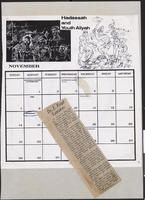Search the Special Collections and Archives Portal
Search Results
Dunes Hotel Photograph Collection
Identifier
Abstract
The Dunes Hotel Photographs (1950-1993) consist of administrative, publicity and entertainment images documenting the history of the Dunes Hotel and Casino in Las Vegas, Nevada. In addition to materials focusing on day-to-day activities at the hotel (correspondence, contracts, personnel, budgets, etc.) the collection provides insight into the hotel’s entertainment and public relations activities. Although there are chronological gaps in the collection, particularly during the later years of the Dunes (1970s-1990s), it provides a significant amount of historical documentation on the famed Strip hotel that was long known to tourists and residents alike as the “the Miracle in the Desert.”
Archival Collection
Las Vegas Ambassadors Collection
Identifier
Abstract
The Las Vegas Ambassadors Collection (1968-1985) primarily consists of a scrapbook, newspaper articles, and photographs documenting the activities of the Las Vegas Ambassadors youth singing group. The materials were compiled by Harry LaFavor, the Ambassadors' business manager, who co-founded the group with Norman Kaye and Richie Astone to promote a positive image of Las Vegas. The collection also includes a songbook, vinyl record and ¼” tape recording, and promotional materials.
Archival Collection
Walking Box Ranch Collection
Identifier
Abstract
The Walking Box Ranch Collection (1917-2011) includes material collected by the University of Nevada, Las Vegas (UNLV) Public Lands Institute on the Searchlight, Nevada ranch. Materials include a maps related to the construction and operation of the ranch, a pair of chaps owned by Rex Bell, Jr., and color slides of the ranch. Also included are photographic prints of Rex Bell and Rex Bell, Jr., and newsclippings related to the film and political career of Rex Bell. A small number of newsclippings pertain to the career of Rex Bell, Jr.
Archival Collection
Ferron and Bracken Photograph Collection
Identifier
Abstract
The Ferron and Bracken Photograph Collection depicts Southern and Central Nevada and other western states from 1890 to 1961. The photographs primarily depict the development and growth of early Las Vegas, Nevada; mines and mining operations in Southern and Central Nevada; towns and mines in Nevada; and the Hoover (Boulder) Dam and the Colorado River.
Archival Collection
Caesars Palace Photograph Collection
Identifier
Abstract
Caesars Palace Photograph Collection (approximately 1965-1989) depicts the famous Caesars Palace Hotel and Casino. The collection consists of twenty-seven images of iconic scenes of Caesars Palace, including its architecture, restaurants, and hotel suites.
Archival Collection
Dottie Dee Dancers Collection
Identifier
Abstract
The Dottie Dee Dancers Collection (approximately 1940-2002) is comprised of newspaper clippings and photographs documenting the career of Dorothy (Dalton) Tomlin who led a line of dancers known as the Dottie Dee Dancers. The dancers performed in nightclubs in Las Vegas, Los Angeles, San Francisco and other western cities. Other items in the collection include scans of the original costume drawings by Hollywood costume designer Lloyd Lambert that were created for the Dottie Dee Dancers, and the transcripts of a 2002 oral history of Dottie and her husband, Donald Tomlin.
Archival Collection
Arthur G. Grant Photograph Collection
Identifier
Abstract
Arthur G. Grant Photograph Collection (approximately 1950-1965) consists of 120mm and 35mm color photographic slides taken in the mid-1950s in and around Las Vegas, Nevada. Images depict Arthur G. Grant's home life, the Fortune Club business on Fremont Street, general downtown, Helldorado Parade, and a Mount Charleston picnic. The collection also contains images of Lake Mead boat races including an appearance by Donald Campbell and his water speed world record-setting jet powered boat, Bluebird.
Archival Collection

John W. Steiger Photograph Collection
Identifier
Abstract
The John Steiger Photograph Collection contains black-and-white photographic prints of H. E. Steiger, John Steiger's father, in and around Las Vegas, Nevada in the 1920s. Images depict H. E. Steiger and various other identified and unidentified individuals in various locations surrounding Las Vegas, including Wilson Ranch, Mount Charleston, and Boulder Canyon. Some images of the Las Vegas Grammar School include John Steiger's mother, who was an elementary school teacher in Las Vegas from 1919 to 1920. The majority of items in this collection are digital surrogates, and the donor retains the original items.
Archival Collection
William Lin Menu Collection
Identifier
Abstract
The William Lin Menu Collection dates from 1972 to 1987 and consists of more than 120 restaurant menus, employee work rules, and customer-service guidelines. Most of the menus are from Chinese restaurants in the San Francisco Bay Area. Other menus describe Chinese and American cuisines at restaurants in Las Vegas, Nevada, and Santa Barbara, California. The collection also includes Chinese restaurant menus from Hong Kong, a 1980 Lufthansa Airlines menu, and late 1970s menus from the Goodtime Charlie’s, Lam’s, Peking Chinese, and Silver Dragon restaurants in Las Vegas.
Archival Collection
